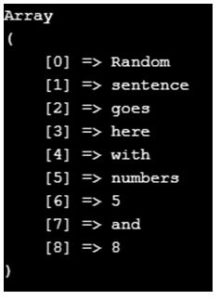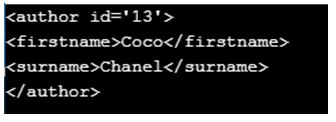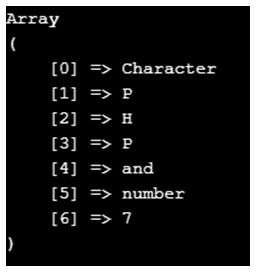The sscanf() is a pre-defined function in PHP which returns parsed input string after parsing it as per the required format. It takes the input of 2 parameters and gives us the required array and in other case when other parameters are passed such as optional ones, the data parsed will be stored in them. It throws an error when there are more specifiers than the variables to contain these and the extra variables will get NULL if there are lower specifiers present than the variables.
Start Your Free Software Development Course
Web development, programming languages, Software testing & others
Syntax of PHP sscanf()
Given below is the syntax of PHP sscanf():
sscanf(input_string, format, arg1, arg2, arg3....)
Input Parameters:
1. input_string: This is the input string to be read.
2. format:?We can specify the formats as per the below list as required:
- %%: This format will be in percent sign.
- %c: This format returns the character as per the ASCII values required.
- %d: This format is for signed decimal value. (Can be zero, negative or positive)
- %e: This format returns scientific notation in lower case. (e.g. 1.2e+2)
- %u: Used for representing unsigned decimal number which is either equal to or greater than zero.
- %f: This is used to represent a floating point number.
- %o: This is used to represent an octal number.
- %s: This represents string format.
- %x: This represent lower case letters for a hexadecimal number.
- %X: This represent uppercase letters for a hexadecimal number.
There are also a few additional format values which are placed between the % symbol and the letter we give. (For example %0.3f)
- + (This forces both + and – values in the beginning of numbers and there are only negative values marked by default).
- ‘ (This describes as to what to be used as a padding and space is the default value here. This should be used along with the width specifier. For example: %x30s which uses x for padding).
- – (This on the left will give us the variable value).
- [0-9] (This gives the minimum width which is held by the variable value).
- . [0-9] (This describes the total number of decimal numbers or the maximum length of the string).
- arg1: This is an optional parameter and also the first variable we store data into.
- arg2: This is also optional and the second variable we store data.
- arg++: This is optional and represents the successive variables we continue storing our data in.
Return values: Here there are 2 cases which can happen:
- If there are only 2 values which are given as input parameters to this function then the data will be returned in the form of an array.
- If other optional parameters are passed then the parsed data are stored in them.
- If there are multiple specifiers exceeding the variables that can contain them then an error is thrown.
- If there are less specifiers than the variables which they can contain, then NULL will be assigned to those variables.
- -1 will be returned if more specifiers are present than in the expected format.
Examples of PHP sscanf()
Given below are the examples mentioned:
Example #1
Code:
<?php $text = "Random sentence goes here with numbers 5 and 8"; $f = sscanf($text,"%s %s %s %s %s %s %d %s %d"); print_r($f); ?>
Output:

In this example we are specifying a text as required. Then using the sscanf function and specifying the correct formats which represents our input string. Hence in the output the exact string is displayed as an array. This only if the format matches the data.
Example #2
Code:
<?php
// fetching the unique ID of product
list($ID) = sscanf("SN/680001", "SN/%d");
// fetching date of manufacturing
$manf = "March 03 2001";
// fetching the date of expiry
$expiry = "March 03 2002";
// Parsing using sscanf function
list($mon, $day, $yr) = sscanf($manf, "%s %d %d");
list($mon, $day, $yr) = sscanf($expiry, "%s %d %d");
echo "Product $ID was manufactured on $manf and will expire on: $yr-" . substr($mon, 0, 3) . "-$day\n";
?>
Output:

In this example we are displaying how to check and display the product information like its Unique manufacturing ID and the date of expiry. So in the first parameter we are fetching the ID information and parsing it in %d format. Next we are fetching the manufacturing date and expiry date of the product and parsing the same as required format using sscanf function. Then displaying all the parsed things in one sentence. Multiple things can be added here to display the information we want.
Example #3
Code:
<?php // Fetching designer info and to generate DressInfo entry $design = "13\tCoco Chanel"; $str = sscanf($design, "%d\t%s %s", $ID, $firstname, $lastname); // Displaying all the above details after formatting echo "<author id='$ID'> <firstname>$firstname</firstname> <surname>$lastname</surname> </author>\n"; ?>
Output:

In this example we are using sscanf function to first parse the ID and name of the designer. Then displaying the same in HTML format by splitting the names into first name and last name.
Example #4
Code:
<?php // We are initializing the string here $arr = "Character PHP and number 7"; // Parsing the input string according to different format $format = sscanf($arr,"%s %c%c%c %s %s? %d"); print_r($format); ?>
Output:

In the above example we are first initializing the string as required and this time including a few character sets in combination with strings. The same we are parsing using the sscanf function.
Conclusion
As seen above in all the examples, sscanf function in PHP is basically used to parse any type of the input string as per the requirements. There are a few cases where this function shows inefficiency to parse the strings, where there may be incorrect output when we try to parse a tab delimited string also having normal spaces in between. It also does not give the expected output if in the code there is a file name with its extension where it finds difficult to separate the two in presence of a “.”.
The above is the detailed content of PHP sscanf(). For more information, please follow other related articles on the PHP Chinese website!

Hot AI Tools

Undress AI Tool
Undress images for free

Undresser.AI Undress
AI-powered app for creating realistic nude photos

AI Clothes Remover
Online AI tool for removing clothes from photos.

Clothoff.io
AI clothes remover

Video Face Swap
Swap faces in any video effortlessly with our completely free AI face swap tool!

Hot Article

Hot Tools

Notepad++7.3.1
Easy-to-use and free code editor

SublimeText3 Chinese version
Chinese version, very easy to use

Zend Studio 13.0.1
Powerful PHP integrated development environment

Dreamweaver CS6
Visual web development tools

SublimeText3 Mac version
God-level code editing software (SublimeText3)

Hot Topics
 How to use PHP to build social sharing functions PHP sharing interface integration practice
Jul 25, 2025 pm 08:51 PM
How to use PHP to build social sharing functions PHP sharing interface integration practice
Jul 25, 2025 pm 08:51 PM
The core method of building social sharing functions in PHP is to dynamically generate sharing links that meet the requirements of each platform. 1. First get the current page or specified URL and article information; 2. Use urlencode to encode the parameters; 3. Splice and generate sharing links according to the protocols of each platform; 4. Display links on the front end for users to click and share; 5. Dynamically generate OG tags on the page to optimize sharing content display; 6. Be sure to escape user input to prevent XSS attacks. This method does not require complex authentication, has low maintenance costs, and is suitable for most content sharing needs.
 PHP creates a blog comment system to monetize PHP comment review and anti-brush strategy
Jul 25, 2025 pm 08:27 PM
PHP creates a blog comment system to monetize PHP comment review and anti-brush strategy
Jul 25, 2025 pm 08:27 PM
1. Maximizing the commercial value of the comment system requires combining native advertising precise delivery, user paid value-added services (such as uploading pictures, top-up comments), influence incentive mechanism based on comment quality, and compliance anonymous data insight monetization; 2. The audit strategy should adopt a combination of pre-audit dynamic keyword filtering and user reporting mechanisms, supplemented by comment quality rating to achieve content hierarchical exposure; 3. Anti-brushing requires the construction of multi-layer defense: reCAPTCHAv3 sensorless verification, Honeypot honeypot field recognition robot, IP and timestamp frequency limit prevents watering, and content pattern recognition marks suspicious comments, and continuously iterate to deal with attacks.
 How to use PHP combined with AI to achieve text error correction PHP syntax detection and optimization
Jul 25, 2025 pm 08:57 PM
How to use PHP combined with AI to achieve text error correction PHP syntax detection and optimization
Jul 25, 2025 pm 08:57 PM
To realize text error correction and syntax optimization with AI, you need to follow the following steps: 1. Select a suitable AI model or API, such as Baidu, Tencent API or open source NLP library; 2. Call the API through PHP's curl or Guzzle and process the return results; 3. Display error correction information in the application and allow users to choose whether to adopt it; 4. Use php-l and PHP_CodeSniffer for syntax detection and code optimization; 5. Continuously collect feedback and update the model or rules to improve the effect. When choosing AIAPI, focus on evaluating accuracy, response speed, price and support for PHP. Code optimization should follow PSR specifications, use cache reasonably, avoid circular queries, review code regularly, and use X
 PHP calls AI intelligent voice assistant PHP voice interaction system construction
Jul 25, 2025 pm 08:45 PM
PHP calls AI intelligent voice assistant PHP voice interaction system construction
Jul 25, 2025 pm 08:45 PM
User voice input is captured and sent to the PHP backend through the MediaRecorder API of the front-end JavaScript; 2. PHP saves the audio as a temporary file and calls STTAPI (such as Google or Baidu voice recognition) to convert it into text; 3. PHP sends the text to an AI service (such as OpenAIGPT) to obtain intelligent reply; 4. PHP then calls TTSAPI (such as Baidu or Google voice synthesis) to convert the reply to a voice file; 5. PHP streams the voice file back to the front-end to play, completing interaction. The entire process is dominated by PHP to ensure seamless connection between all links.
 How to use PHP to combine AI to generate image. PHP automatically generates art works
Jul 25, 2025 pm 07:21 PM
How to use PHP to combine AI to generate image. PHP automatically generates art works
Jul 25, 2025 pm 07:21 PM
PHP does not directly perform AI image processing, but integrates through APIs, because it is good at web development rather than computing-intensive tasks. API integration can achieve professional division of labor, reduce costs, and improve efficiency; 2. Integrating key technologies include using Guzzle or cURL to send HTTP requests, JSON data encoding and decoding, API key security authentication, asynchronous queue processing time-consuming tasks, robust error handling and retry mechanism, image storage and display; 3. Common challenges include API cost out of control, uncontrollable generation results, poor user experience, security risks and difficult data management. The response strategies are setting user quotas and caches, providing propt guidance and multi-picture selection, asynchronous notifications and progress prompts, key environment variable storage and content audit, and cloud storage.
 PHP realizes commodity inventory management and monetization PHP inventory synchronization and alarm mechanism
Jul 25, 2025 pm 08:30 PM
PHP realizes commodity inventory management and monetization PHP inventory synchronization and alarm mechanism
Jul 25, 2025 pm 08:30 PM
PHP ensures inventory deduction atomicity through database transactions and FORUPDATE row locks to prevent high concurrent overselling; 2. Multi-platform inventory consistency depends on centralized management and event-driven synchronization, combining API/Webhook notifications and message queues to ensure reliable data transmission; 3. The alarm mechanism should set low inventory, zero/negative inventory, unsalable sales, replenishment cycles and abnormal fluctuations strategies in different scenarios, and select DingTalk, SMS or Email Responsible Persons according to the urgency, and the alarm information must be complete and clear to achieve business adaptation and rapid response.
 How to use PHP to develop AI-driven advertising delivery PHP advertising performance optimization solution
Jul 25, 2025 pm 06:12 PM
How to use PHP to develop AI-driven advertising delivery PHP advertising performance optimization solution
Jul 25, 2025 pm 06:12 PM
PHP provides an input basis for AI models by collecting user data (such as browsing history, geographical location) and pre-processing; 2. Use curl or gRPC to connect with AI models to obtain click-through rate and conversion rate prediction results; 3. Dynamically adjust advertising display frequency, target population and other strategies based on predictions; 4. Test different advertising variants through A/B and record data, and combine statistical analysis to optimize the effect; 5. Use PHP to monitor traffic sources and user behaviors and integrate with third-party APIs such as GoogleAds to achieve automated delivery and continuous feedback optimization, ultimately improving CTR and CVR and reducing CPC, and fully implementing the closed loop of AI-driven advertising system.
 Beyond the LAMP Stack: PHP's Role in Modern Enterprise Architecture
Jul 27, 2025 am 04:31 AM
Beyond the LAMP Stack: PHP's Role in Modern Enterprise Architecture
Jul 27, 2025 am 04:31 AM
PHPisstillrelevantinmodernenterpriseenvironments.1.ModernPHP(7.xand8.x)offersperformancegains,stricttyping,JITcompilation,andmodernsyntax,makingitsuitableforlarge-scaleapplications.2.PHPintegrateseffectivelyinhybridarchitectures,servingasanAPIgateway






